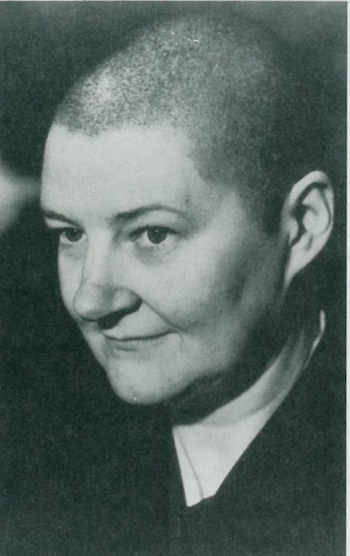
Roshi Jiyu-Kennett, founder of Shasta Abbey, died on November 6, at the age of seventy-two. In thirty-three years of teaching, she guided hundreds of students, and her books, including The Wild, White Goose (1977, 1978) andSelling Water by the River(1972),* are read widely by Western Zen practitioners. In her last years of life, however, Kennett Roshi increasingly isolated herself from other Zen lineages in the United States and Japan.
She was born Peggy Kennett in England, the daughter of a tailor. As a young woman, she joined the Royal Navy. After World War II, she studied medieval musicology at Durham University in the north of England and worked as a church organist—all the while practicing Theravada Buddhism. Later, she was introduced to Zen by the works of D. T. Suzuki, and joined the London Buddhist Society where, in 1960, she met Keido Chisan, a Zen abbot from Yokohama, Japan. A year later, she traveled to Malaysia and then to Soji-ji Temple in Japan to become Keido Chisan’s formal disciple. She received dharma transmission from him in 1963.
Keido Chisan was known for his work on behalf of women, and with his support, Kennett Roshi received Soto certifications usually off-limits to foreigners and largely unheard of for women—she even served as abbess of her own temple. She lived and studied in Japan from 1961 to 1968. Following Keido Chisan’s death, however, she found life in Japan increasingly difficult. By 1969, she had moved to San Francisco and founded the Zen Mission Society. In 1971, the group purchased land near Mount Shasta, in the most northern reach of California. There she established Shasta Zen Chisan-ji, a residential monastery based on the Japanese methods in which she was trained, but flavored with her independent spirit, practical style, and Western heritage. (The Zen Mission Society eventually changed its name to the Order of 8uddhist Contemplatives, and the temple to Shasta Abbey.) “Interpreting [Zen] in an American setting was a lot easier than I had expected,” she once wrote. “It boiled down to not trying to change anything whatsoever; when changes occurred, they did so very gradually, of their own accord and were only in the outside forms (chopsticks at meals were the first to go).”
Kennett Roshi honed a unique method of singing the traditional daily Soto Zen scriptures in a Gregorian style similar to that used by the Church of England—the outcome was a sound remarkably similar to Pali and Sanskrit chanting styles. English high tea replaced the Japanese tea ceremony. And Kennett Roshi was a prolific translator, publishing many Soto scriptures in English.
In her work at Shasta Abbey, she stressed the fundamental Buddhist teachings and the precepts as the bedrock of practice, and she strongly emphasized the master-disciple relationship. Kennett Roshi ordained more than 100 disciples, and sometimes as many as fifty monks lived at the Abbey at a time, with men and women following identical courses of training. One senior disciple remembers her often saying how her job was not to lighten the load of a disciple, but to make the load so heavy that he or she would put it down.
Kennett Roshi suffered from poor health for several years and died of complications from diabetes.
*Selling Water By the River was republished in 1987 as Zen Is Eternal Life by Shasta Abbey Press.
Thank you for subscribing to Tricycle! As a nonprofit, we depend on readers like you to keep Buddhist teachings and practices widely available.